Transform your bedroom from a basic sleeping space into an enchanted botanical sanctuary with the strategic placement of air-purifying plants. You’ll discover how nine specific plant varieties can dramatically improve your room’s air quality while creating a tranquil atmosphere for rest. From low-maintenance options that thrive in shade to fragrant varieties that promote better sleep, each plant serves a unique purpose in your bedroom’s ecosystem. Let’s explore which green companions will best suit your space and lifestyle.
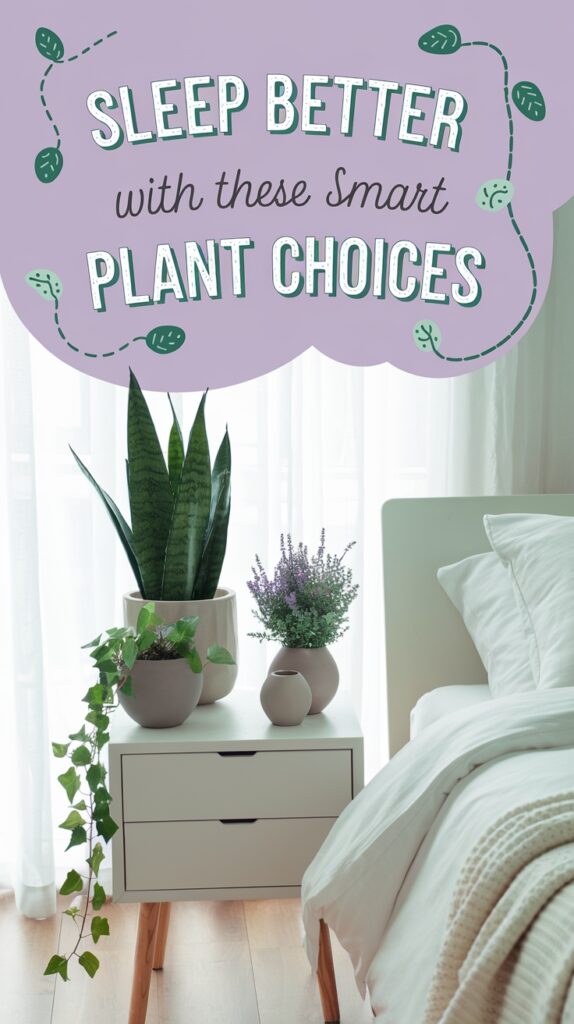
Contents
- 1 Snake Plant: The Ultimate Air-Purifying Bedroom Companion
- 2 Pothos: Trailing Beauty for Your Bedroom Corner
- 3 Peace Lily: Elegant White Blooms for Serene Spaces
- 4 ZZ Plant: Low-Light Champion for Dark Bedrooms
- 5 Lavender: Nature’s Sleep Aid for Your Nightstand
- 6 Spider Plant: Easy-Care Green Cascades
- 7 Bamboo Palm: Tropical Vibes for Better Sleep
- 8 String of Pearls: Dreamy Windowsill Decor
- 9 Jade Plant: Prosperity and Peace in Your Sleep Space
Snake Plant: The Ultimate Air-Purifying Bedroom Companion
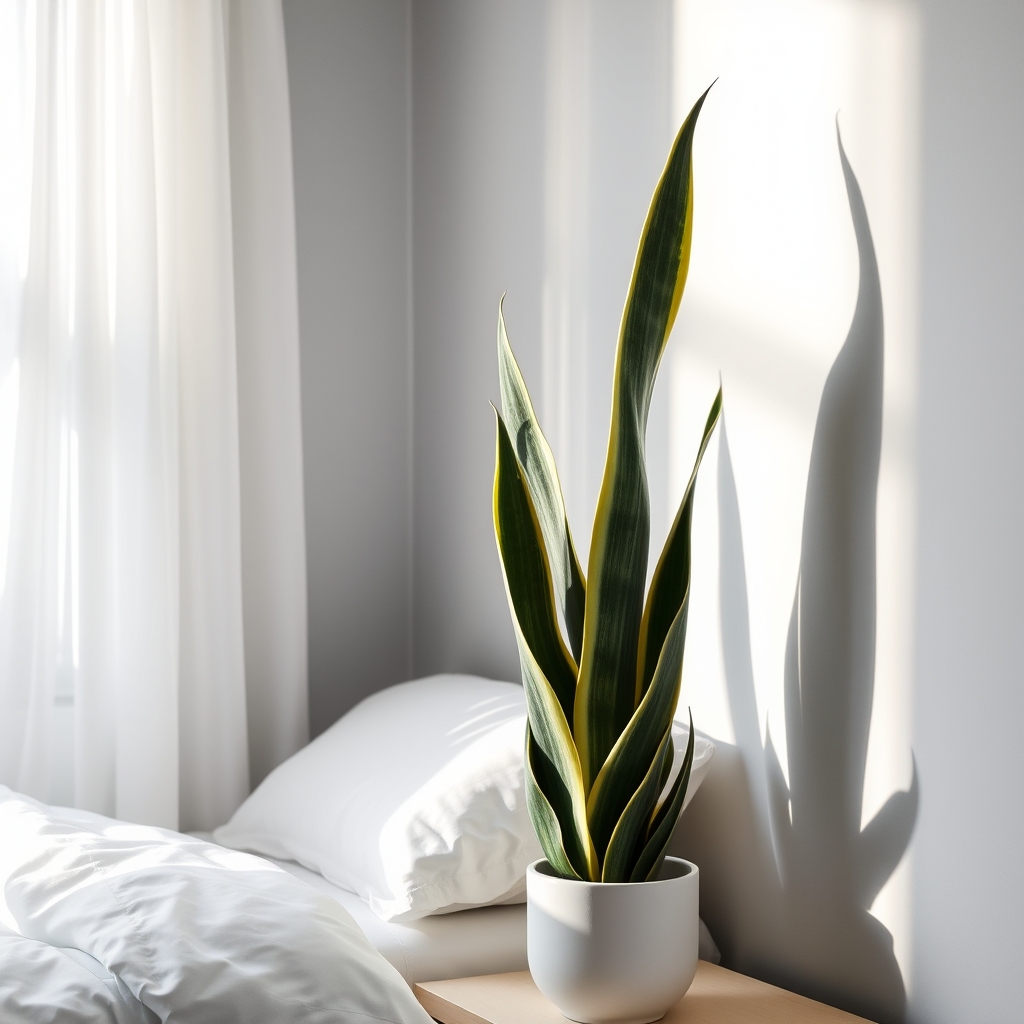
The Snake Plant (Sansevieria trifasciata) is a striking architectural plant characterized by its tall, rigid, sword-like leaves that grow vertically in a rosette pattern.
These leaves feature distinctive dark green bands with light green or yellow edges, depending on the variety. Known for its exceptional air-purifying abilities, the snake plant effectively removes toxins like formaldehyde, benzene, and trichloroethylene from indoor air, making it an excellent choice for bedrooms.
It’s also one of the few plants that convert CO2 to oxygen at night, promoting better sleep quality.
- Light: Tolerates low light but thrives in indirect bright light; can handle some direct sun
- Water: Allow soil to dry completely between waterings; water less in winter
- Soil: Well-draining potting mix; preferably succulent or cactus soil
- Temperature: Comfortable in normal room temperatures (60-85°F)
- Humidity: Adaptable to various humidity levels; no special requirements
Regular maintenance of a snake plant is minimal, but attention to a few key practices ensures optimal health.
Dust the leaves monthly with a damp cloth to maintain their photosynthetic efficiency and aesthetic appeal. Remove any yellow or damaged leaves at the base, and check occasionally for signs of root rot, which can develop if the plant is overwatered.
Repot every 2-3 years when the plant becomes root-bound, and divide larger plants to propagate new specimens or maintain a manageable size.
Pothos: Trailing Beauty for Your Bedroom Corner
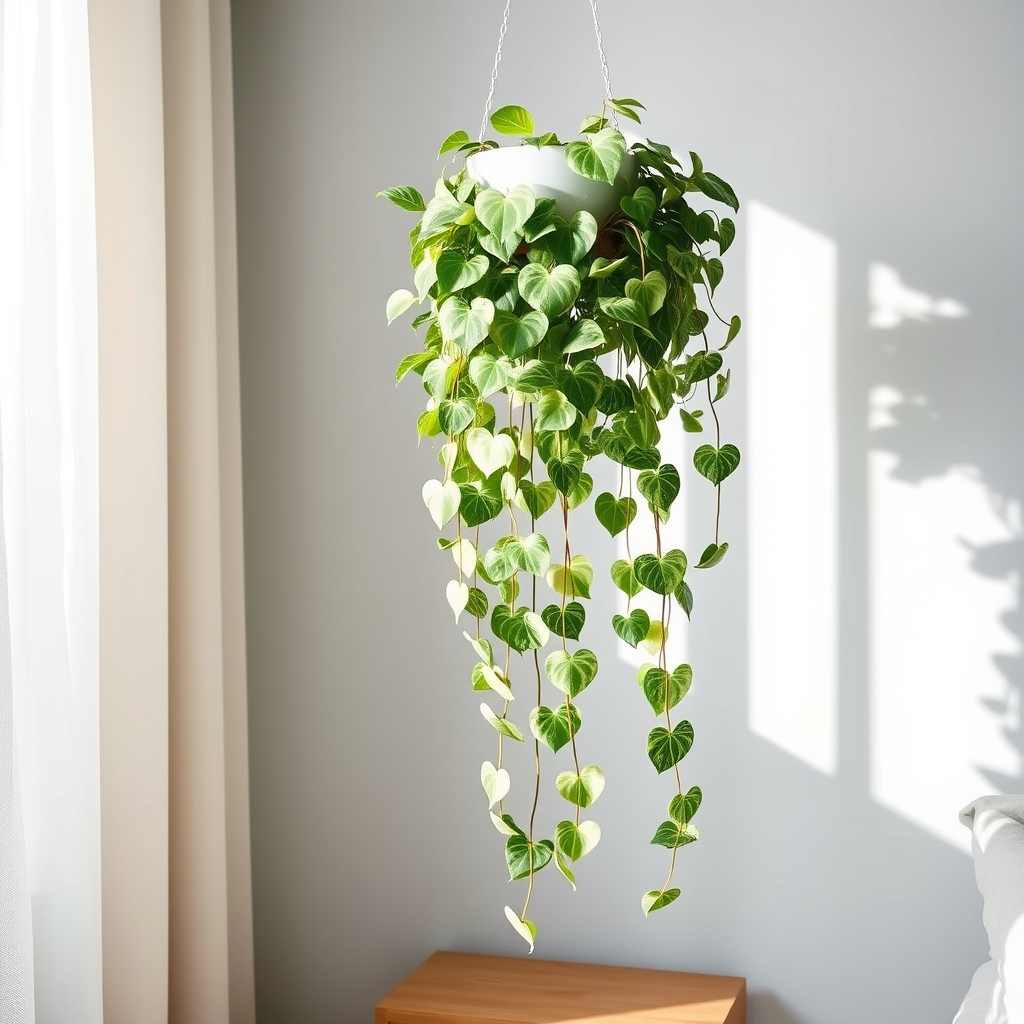
Pothos (Epiphoremum aureum) is a versatile trailing plant known for its heart-shaped leaves that cascade elegantly from shelves, hanging baskets, or climb up trellises in bedroom corners.
This popular houseplant comes in various varieties, featuring leaves with different patterns of green, yellow, white, or marble variegation, making it an attractive addition to any bedroom decor. The vines can grow several feet long, creating a dramatic waterfall effect when properly positioned.
- Light: Thrives in medium to bright indirect light; tolerates low light but may lose variegation
- Water: Allow top 1-2 inches of soil to dry between waterings
- Soil: Well-draining potting mix
- Temperature: 60-80°F (15-27°C)
- Humidity: Adaptable to average indoor humidity levels
- Container: Any pot with drainage holes
Regular pruning keeps pothos looking full and prevents leggy growth, while periodic wiping of leaves with a damp cloth removes dust and maintains the plant’s glossy appearance.
To encourage bushier growth, pinch back growing tips and propagate the cuttings in water to create new plants.
Watch for yellowing leaves, which often indicate overwatering, and trim away any dead or damaged foliage to maintain the plant’s healthy appearance and prevent disease spread.
Peace Lily: Elegant White Blooms for Serene Spaces
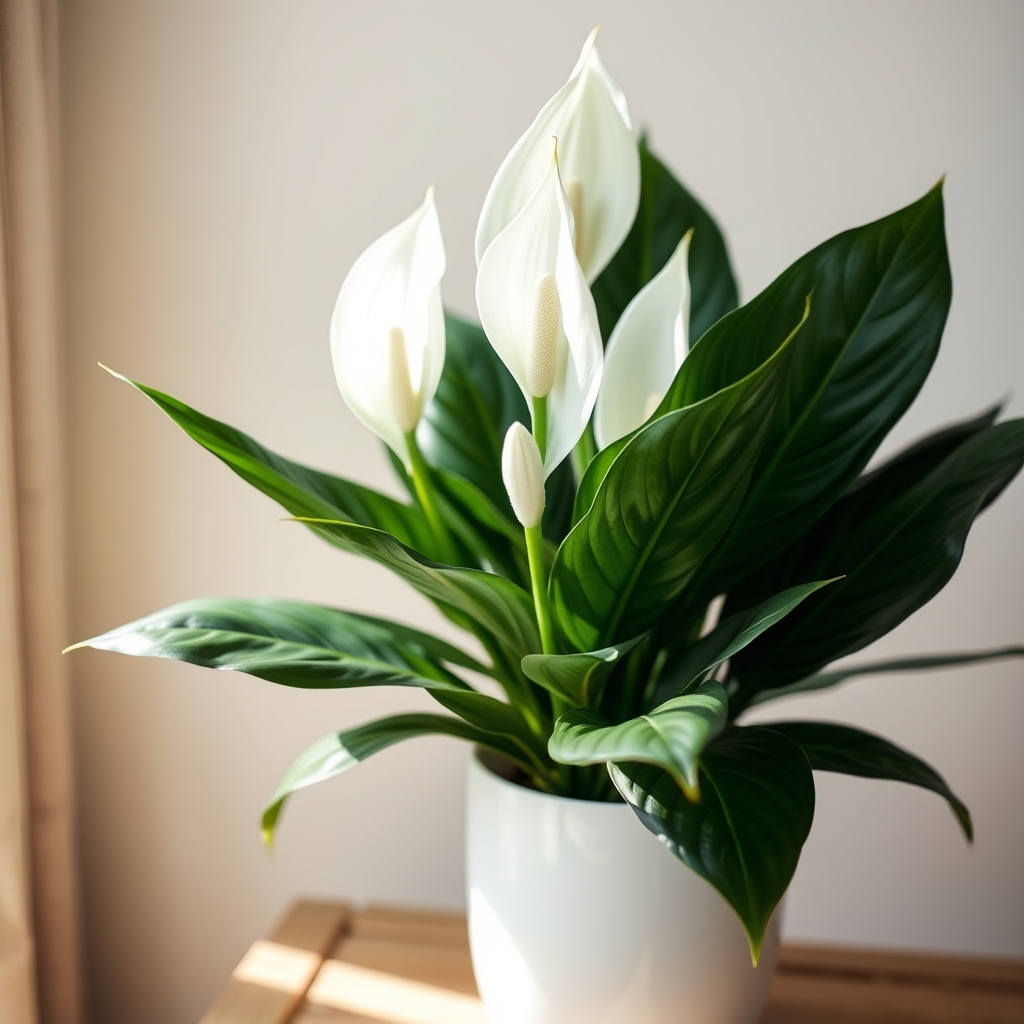
The Peace Lily (Spathiphyllum) is a sophisticated houseplant known for its striking white flowers and glossy, dark green foliage. These elegant plants feature long, lance-shaped leaves that emerge from the base, creating a fountain-like appearance. The distinctive white blooms, which aren’t true flowers but rather modified leaves called spathes, rise above the foliage on long stems and can flower multiple times throughout the year, making them a continuous source of natural beauty in bedroom spaces.
- Light: Thrives in medium to low indirect light; avoid direct sunlight
- Water: Keep soil consistently moist but not waterlogged; water when top inch of soil feels dry
- Humidity: Prefers high humidity levels around 50-60%
- Temperature: Maintains best growth between 65-80°F (18-27°C)
- Soil: Well-draining, rich potting mix with good organic content
- Fertilizer: Monthly feeding with balanced liquid fertilizer during growing season
Regular grooming is essential for maintaining a healthy Peace Lily. Remove yellowed or damaged leaves at the base using clean, sharp scissors, and dust the leaves periodically with a damp cloth to maintain their glossy appearance and ensure proper photosynthesis.
Trim spent flowers at the base of their stems to encourage new blooms, and consider repotting every 1-2 years when the plant becomes root-bound, which is indicated by roots growing through drainage holes or the plant requiring more frequent watering.
ZZ Plant: Low-Light Champion for Dark Bedrooms

The ZZ Plant (Zamioculcas zamiifolia) stands out as an exceptional choice for bedrooms with minimal natural light. Its glossy, dark green leaves grow in a distinctive feather-like pattern along thick, upright stems, creating an elegant architectural presence that can reach up to 3 feet tall. This virtually indestructible houseplant stores water in its thick rhizomes, allowing it to withstand periods of neglect while maintaining its pristine appearance.
- Light: Thrives in low to moderate indirect light; can tolerate very low light conditions
- Water: Allow soil to dry completely between waterings; water every 2-3 weeks
- Soil: Well-draining potting mix with added perlite
- Temperature: Comfortable in normal room temperatures between 65-75°F
- Humidity: Adapts to average indoor humidity levels
- Fertilizer: Light feeding with balanced houseplant fertilizer every 3-4 months during growing season
Regular maintenance of a ZZ Plant primarily involves dust removal from its waxy leaves using a soft, damp cloth to maintain photosynthesis efficiency and aesthetic appeal.
Remove any yellowing or damaged leaves at the base of the stem, and rotate the plant quarterly to ensure even growth.
While the plant is highly resistant to pests, occasional inspection of leaf undersides and stem joints helps catch potential issues early, ensuring continued health and vitality.
Lavender: Nature’s Sleep Aid for Your Nightstand
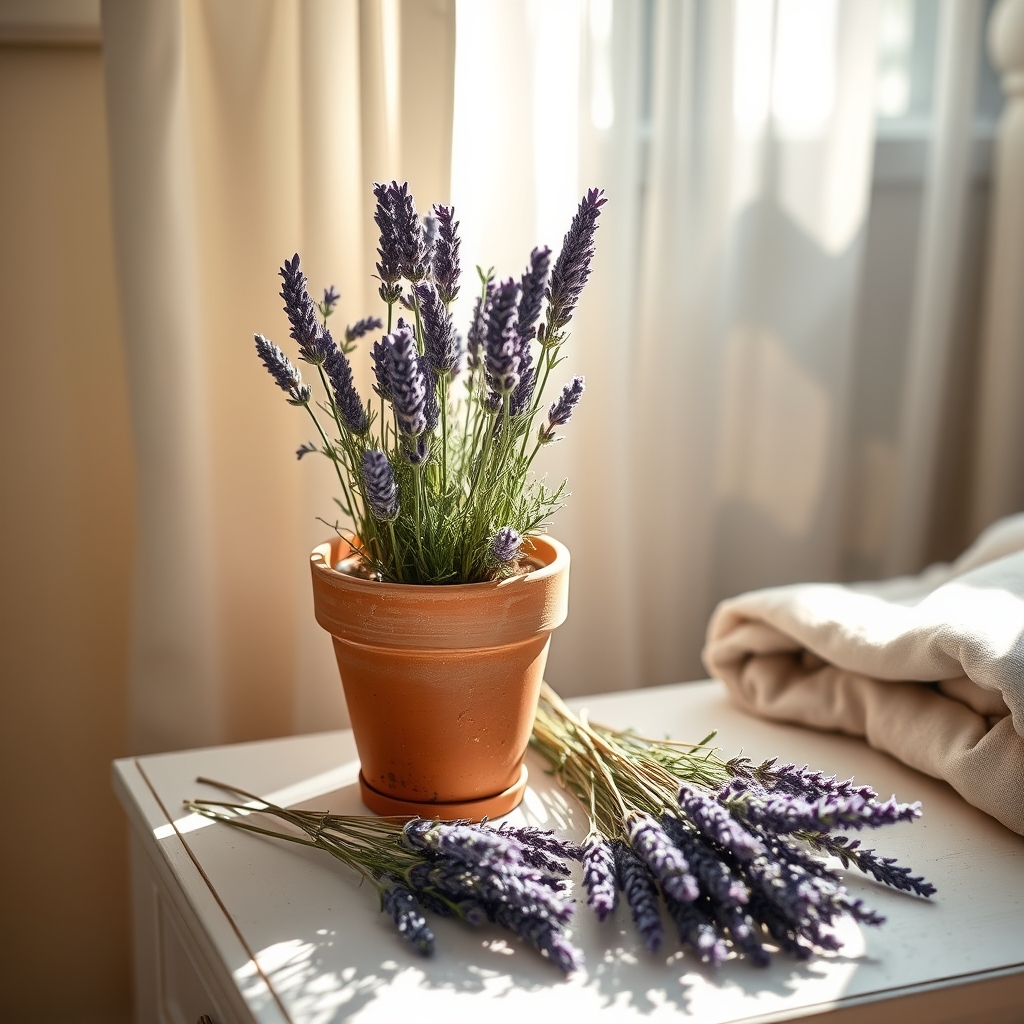
Lavender, with its signature purple-blue spiky blooms and silvery-green foliage, brings both visual charm and therapeutic benefits to the bedroom environment. This aromatic Mediterranean herb is renowned for its natural sedative properties, releasing a soothing fragrance that can promote relaxation and better sleep quality. Its compact, bushy form makes it an ideal nightstand companion, typically growing 1-2 feet tall in container settings.
- Light: Requires 6-8 hours of direct sunlight daily; place near a sunny window
- Water: Allow soil to dry between waterings; drought-tolerant once established
- Soil: Well-draining, sandy or gravelly soil with pH 6.7-7.3
- Temperature: Prefers 65-70°F (18-21°C)
- Humidity: Low to moderate; thrives in dry conditions
- Container: Terra cotta pot with drainage holes
Regular pruning is essential to maintain lavender’s compact shape and encourage continuous blooming. Trim spent flower stalks and shape the plant in early spring and after the first bloom cycle.
Remove any yellowing leaves promptly to prevent fungal issues, and avoid overfeeding – lavender actually performs better in lean soil conditions. For optimal fragrance production, gently brush your hands across the foliage occasionally, which stimulates the release of essential oils.
Spider Plant: Easy-Care Green Cascades
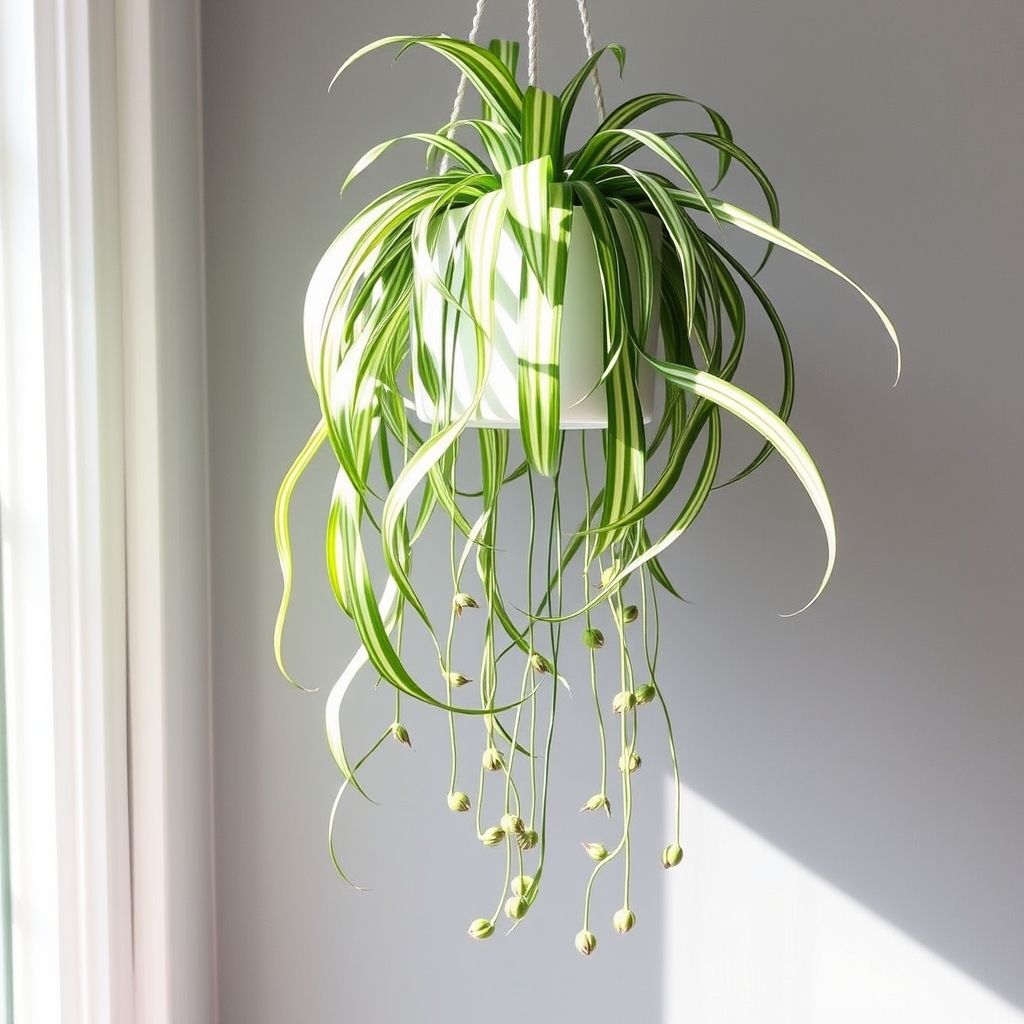
Spider plants (Chlorophytum comosum) are beloved houseplants known for their arching, grass-like foliage and distinctive trailing plantlets that dangle from long stems, creating a graceful cascading effect.
The main plant produces slender, variegated leaves in green and white stripes, while the baby plants, called “spiderettes,” grow on thin runners, giving the plant its spider-like appearance and making it perfect for hanging baskets or elevated shelves in bedrooms.
- Light: Bright indirect light; tolerates moderate light but avoids direct sun
- Water: Allow top inch of soil to dry between waterings; reduced watering in winter
- Humidity: Adapts to average room humidity; benefits from occasional misting
- Temperature: Thrives in 60-75°F (15-24°C)
- Soil: Well-draining potting mix rich in organic matter
- Fertilizer: Monthly feeding during growing season with balanced houseplant fertilizer
Regular grooming keeps spider plants looking their best and encourages healthy growth.
Remove any yellow or brown leaves at the base, and trim off spent runners once spiderettes have been removed for propagation.
Watch for brown leaf tips, which often indicate fluoride sensitivity – using distilled water or rainwater can help prevent this issue.
Repot every 2-3 years when roots become crowded, and consider dividing larger plants to maintain their compact shape and promote vigorous growth.
Bamboo Palm: Tropical Vibes for Better Sleep
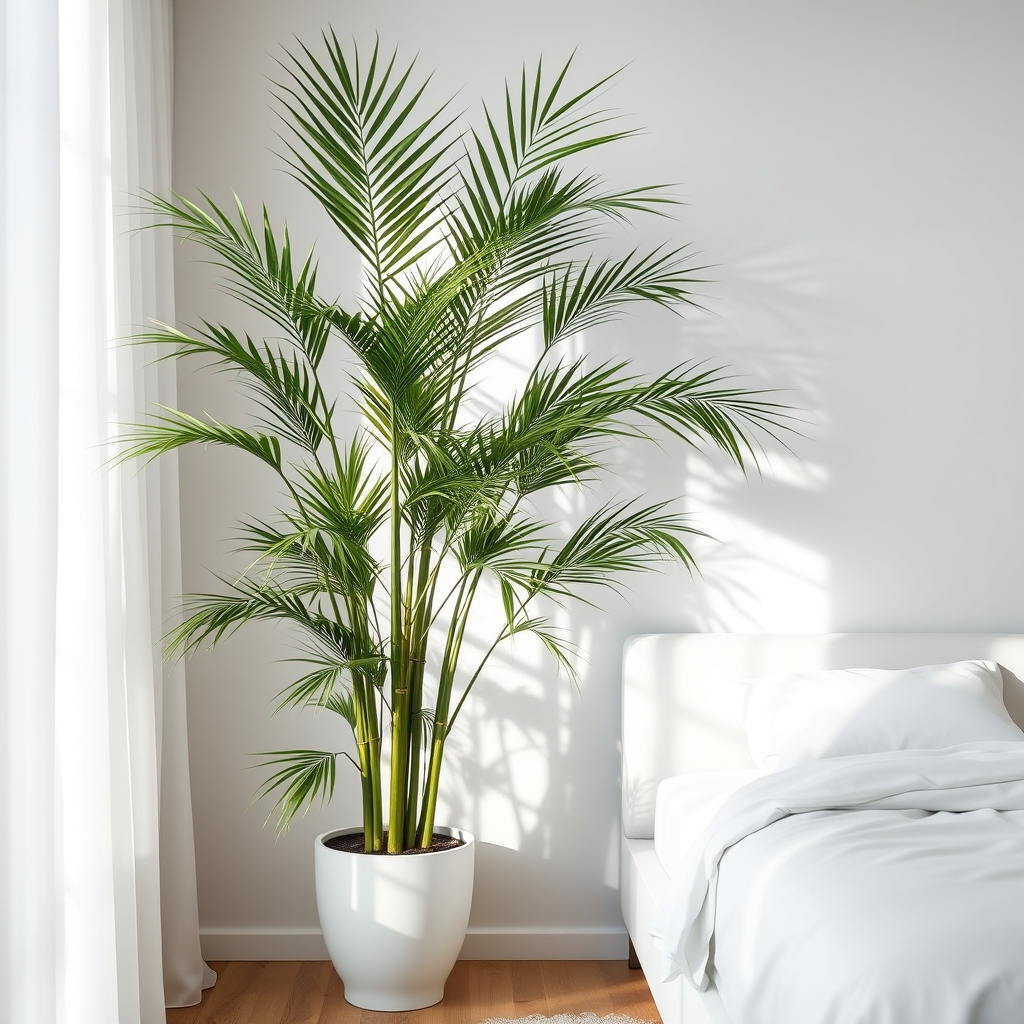
The Bamboo Palm (Chamaedorea seifrizii) brings a slice of tropical paradise to any bedroom with its elegant, feathery fronds and slender, reed-like stems that can reach heights of 4-12 feet indoors.
This air-purifying powerhouse not only adds a lush, exotic touch to your sleep sanctuary but also effectively removes indoor air pollutants like formaldehyde and benzene, contributing to a healthier sleeping environment.
- Light: Bright, indirect sunlight; tolerates moderate shade
- Water: Keep soil consistently moist but not waterlogged; water when top inch of soil feels dry
- Soil: Well-draining, rich potting mix with added organic matter
- Humidity: Prefers moderate to high humidity (40-50%)
- Temperature: 65-80°F (18-27°C)
- Fertilizer: Feed monthly during growing season with balanced liquid fertilizer
Regular grooming is essential for maintaining a healthy Bamboo Palm, including removing any yellowed or brown fronds at the base and wiping dust from leaves with a damp cloth to maintain optimal photosynthesis.
Inspect the plant periodically for spider mites, which can be deterred by maintaining proper humidity levels, and trim any damaged stems at soil level to encourage new growth and maintain the plant’s attractive appearance.
String of Pearls: Dreamy Windowsill Decor
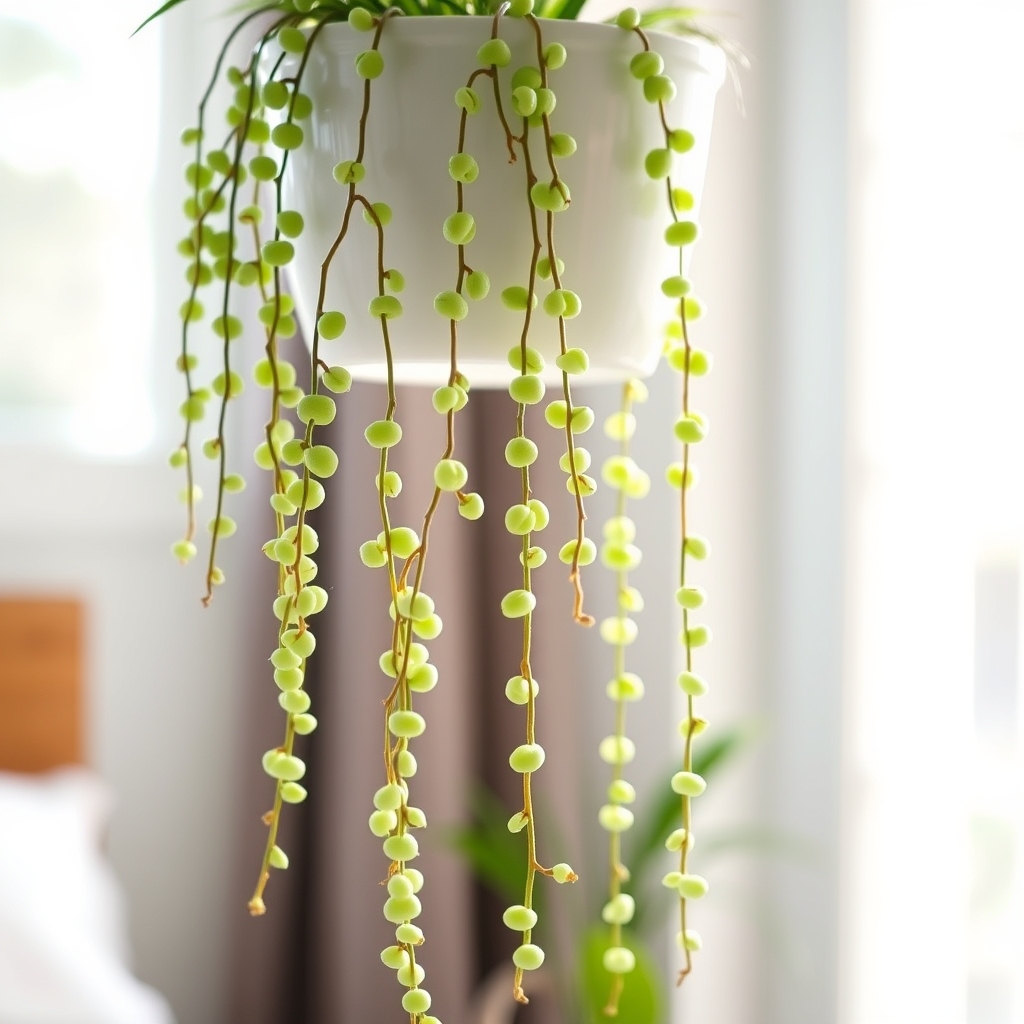
String of Pearls (Senecio rowleyanus) is a captivating trailing succulent that creates a stunning cascading effect with its delicate, spherical leaves resembling a strand of green pearls. This unique plant can grow several feet long, making it perfect for hanging baskets or high shelves where its graceful stems can freely cascade downward, adding a whimsical and elegant touch to any bedroom window display.
- Light: Bright, indirect sunlight; morning sun is ideal; protect from harsh afternoon rays
- Water: Allow soil to dry between waterings; reduce watering in winter
- Soil: Well-draining succulent or cactus mix
- Temperature: 70-80°F (21-27°C); minimum 55°F (13°C)
- Humidity: Average room humidity; tolerates dry conditions
- Container: Pot with drainage holes essential
Regular pruning helps maintain the plant’s desired shape and promotes fuller growth, while removing any dried or yellowing strands keeps it looking fresh.
Watch for signs of pests like mealybugs, treating them promptly with insecticidal soap if spotted. Avoid overhandling the delicate stems, as they can break easily, and consider propagating healthy stem cuttings in spring or summer to create new plants or fill in sparse areas.
Jade Plant: Prosperity and Peace in Your Sleep Space
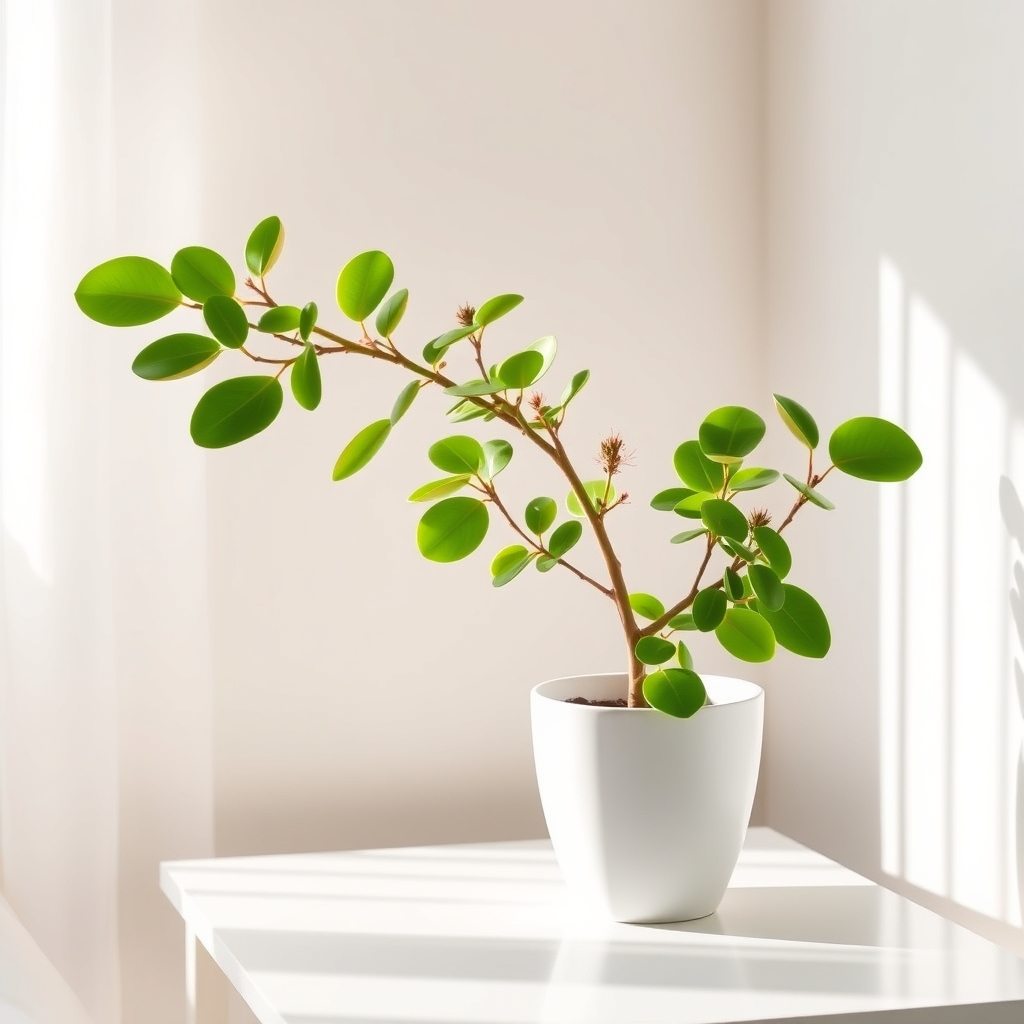
The Jade Plant (Crassula ovata) is a beloved succulent known for its thick, oval-shaped leaves and sturdy woody stems that create a tree-like appearance.
Often called the “Money Plant” or “Lucky Plant” in Asian cultures, this compact evergreen can grow up to 3 feet tall indoors, featuring clusters of small white or pink flowers when mature. Its glossy, jade-green leaves store water, giving the plant a plump, healthy appearance that adds a touch of serenity to any bedroom space.
Growing Conditions:
- Bright, indirect sunlight with some direct morning sun
- Well-draining potting mix specifically designed for succulents
- Temperature between 65-75°F (18-24°C)
- Low humidity levels
- Water thoroughly only when top soil is completely dry
- Pot with drainage holes to prevent root rot
To maintain a thriving Jade Plant, regular pruning is essential to control its shape and encourage bushier growth.
Remove any yellowing or fallen leaves promptly to prevent pest issues, and dust the leaves monthly with a soft cloth to maintain their characteristic shine.
During the growing season (spring and summer), feed the plant with a balanced, water-soluble fertilizer diluted to half strength every 6-8 weeks, but suspend fertilization during winter months when growth naturally slows.
